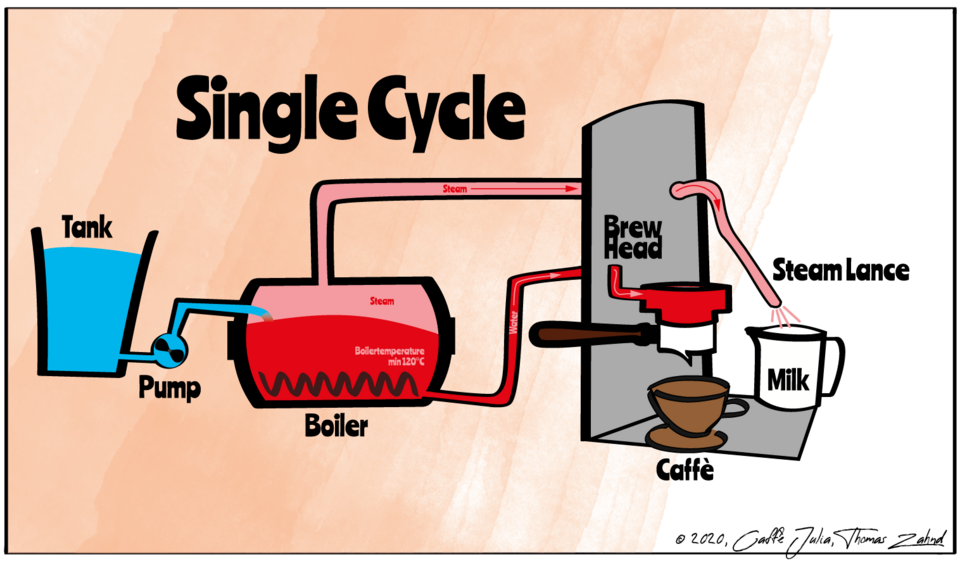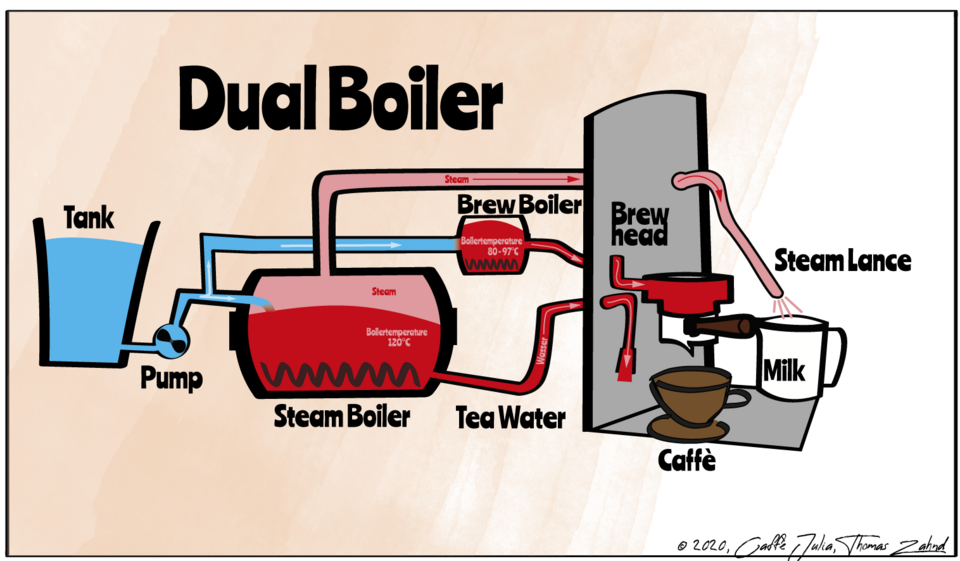Are you a coffee aficionado who enjoys the perfect cup of Joe every morning? If so, you may have heard the term “boiler type” when researching coffee machines. But what exactly is a coffee machine’s boiler type, and does it really make a difference in the quality of your coffee? In this article, we will explore the various types of boiler systems used in coffee machines and determine whether or not it impacts the taste and brewing process. So grab a cup of your favorite brew and let’s dive into the world of coffee machine boilers!

Coffee Machine Boiler Types
When it comes to coffee machines, the boiler type plays a crucial role in determining the quality of your brew. Different boiler types offer distinct advantages and disadvantages, so understanding the options available can help you make an informed decision. In this comprehensive article, we will explore four common coffee machine boiler types: traditional boiler, thermoblock boiler, dual boiler, and heat exchange boiler.
Let’s dive into each boiler type and explore their description, advantages, and disadvantages.
Traditional Boiler
Description
A traditional boiler, also known as a single boiler, is the most basic type of boiler found in coffee machines. It consists of a large metal container that heats the water to the desired temperature for brewing and steaming.
Advantages
- Cost-effective: Coffee machines with traditional boilers are often more affordable compared to other boiler types.
- Compact size: Traditional boilers are typically smaller in size, making them ideal for compact coffee machines or limited countertop space.
- Simplicity: The straightforward design of a traditional boiler makes it easier to operate and maintain.
Disadvantages
- Wait time: With a traditional boiler, you need to wait for the water to heat up to the right temperature, which can take a few minutes. This can be inconvenient if you’re in a hurry or require multiple brews.
- Temperature stability: Traditional boilers may struggle to maintain a consistent brewing temperature, resulting in variations in the quality of your shots.
- Limited steam production: Since the same boiler is used for brewing and steaming, you may experience delays in producing steam for milk-based beverages.

Thermoblock Boiler
Description
A thermoblock boiler consists of a small metal block with heating elements embedded in it. The water passes through the block and is heated on-demand as it flows towards the coffee group or the steam wand.
Advantages
- Rapid heating: Thermoblock boilers heat up quickly, allowing you to start brewing almost immediately after turning on the machine.
- Temperature control: These boilers offer precise temperature control, ensuring consistent and accurate brewing temperatures for your coffee.
- Space-saving: Thermoblock boilers are compact and can fit into smaller coffee machines without compromising functionality.
Disadvantages
- Limited steam production: Like traditional boilers, thermoblock boilers may struggle with steam production due to the need to prioritize heating the water for brewing.
- Susceptible to scale buildup: The small, enclosed design of thermoblock boilers can make them susceptible to scale buildup, requiring regular maintenance and descaling to ensure optimal performance.

Dual Boiler
Description
As the name suggests, the dual boiler coffee machines feature two separate boilers—one dedicated to brewing and one for steaming. This design allows for simultaneous operation and independent control of temperature for each function.
Advantages
- Temperature stability: Dual boiler machines offer excellent temperature stability for both brewing and steaming, resulting in consistent shot quality.
- Simultaneous brewing and steaming: With separate boilers, you can brew your coffee and steam milk simultaneously, saving you valuable time.
- Professional-grade performance: Dual boiler machines are often favored by baristas and coffee enthusiasts for their ability to replicate the precise brewing conditions found in commercial coffee shops.
Disadvantages
- Higher cost: Dual boiler coffee machines tend to be more expensive due to the additional boiler and advanced technology required.
- Larger footprint: The presence of two boilers means dual boiler machines often take up more space on your countertop compared to other boiler types.

Heat Exchange Boiler
Description
Heat exchange boilers utilize a large metal tube or coil that contains heated water. As the cold water is pumped through the coil or tube, it absorbs heat from the surrounding hot water, instantly heating it to the appropriate temperature.
Advantages
- Steam production: Heat exchange boilers excel in steam production, allowing you to effortlessly create creamy, velvety microfoam for your cappuccinos and lattes.
- Temperature stability: The design of heat exchange boilers ensures consistent brewing temperatures, resulting in reliable shot quality.
- Simultaneous operation: Like dual boiler machines, heat exchange boilers enable you to brew and steam at the same time.
Disadvantages
- Temperature adjustment: Heat exchange boilers may require some skill and practice to adjust the brewing temperature, as they rely on pressure and water flow rate to control heat transfer.
- Initial cooling flush: Due to the nature of heat exchange boilers, a small amount of hot water needs to be flushed before pulling a shot to ensure the brewing temperature is ideal.

Factors to Consider
Now that we’ve explored each boiler type, let’s consider some key factors that can help you determine which one is best suited for your needs.
Brewing Temperature
When it comes to brewing temperature, all boiler types have their own advantages and considerations.
Traditional Boiler
Traditional boilers may struggle with maintaining a consistent brewing temperature, which can affect the quality and flavor of your shots.
Thermoblock Boiler
Thermoblock boilers offer precise temperature control, ensuring your coffee is brewed at a consistent temperature, resulting in optimal flavors.
Dual Boiler
Dual boiler machines excel in temperature stability, offering precise control over both brewing and steaming temperatures.
Heat Exchange Boiler
Heat exchange boilers are designed to maintain consistent brewing temperatures, delivering reliable shot quality.
Shot Consistency
If shot consistency is a priority, certain boiler types may offer better results.
Traditional Boiler
Due to temperature fluctuations, traditional boilers might result in shot inconsistencies, requiring more skill and practice to achieve consistent results.
Thermoblock Boiler
Thermoblock boilers provide excellent shot consistency due to their precise temperature control.
Dual Boiler
Dual boiler machines are renowned for their shot consistency, replicating commercial-grade espresso machines.
Heat Exchange Boiler
Heat exchange boilers also offer reliable shot consistency, making them a popular choice among coffee enthusiasts.
Steam Production
If you enjoy milk-based beverages, steam production is an important factor to consider.
Traditional Boiler
The limited steam production of traditional boilers may result in longer wait times for the milk to be steamed.
Thermoblock Boiler
Thermoblock boilers may struggle with rapid steam production due to the need to prioritize water heating for brewing.
Dual Boiler
Dual boiler machines excel in steam production, allowing for quick and efficient steaming of milk.
Heat Exchange Boiler
Heat exchange boilers offer excellent steam production capabilities, providing ample steam for your milk-based drinks.
Cost
Cost is a significant consideration for many when purchasing a coffee machine.
Traditional Boiler
Traditional boiler machines tend to be more budget-friendly compared to other boiler types.
Thermoblock Boiler
Thermoblock boilers often fall within a mid-range price point, offering a balance between affordability and functionality.
Dual Boiler
Dual boiler machines are typically more expensive due to their advanced technology and professional-grade performance.
Heat Exchange Boiler
Heat exchange boilers can vary in price, with some models falling within the mid-range and others considered high-end.
In conclusion, the type of boiler in your coffee machine does matter. Each boiler type offers its own set of advantages and disadvantages, so it’s essential to consider factors like brewing temperature, shot consistency, steam production, maintenance, and cost when making a decision. Whether you prioritize precise temperature control or simultaneous brewing and steaming, understanding the different boiler types will help you choose the perfect coffee machine for your needs. Happy brewing!
